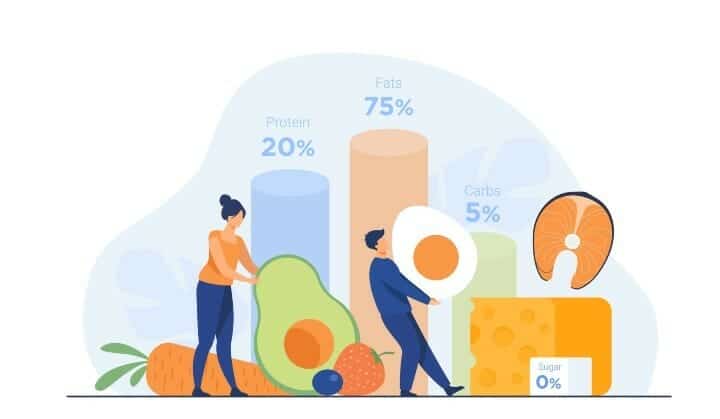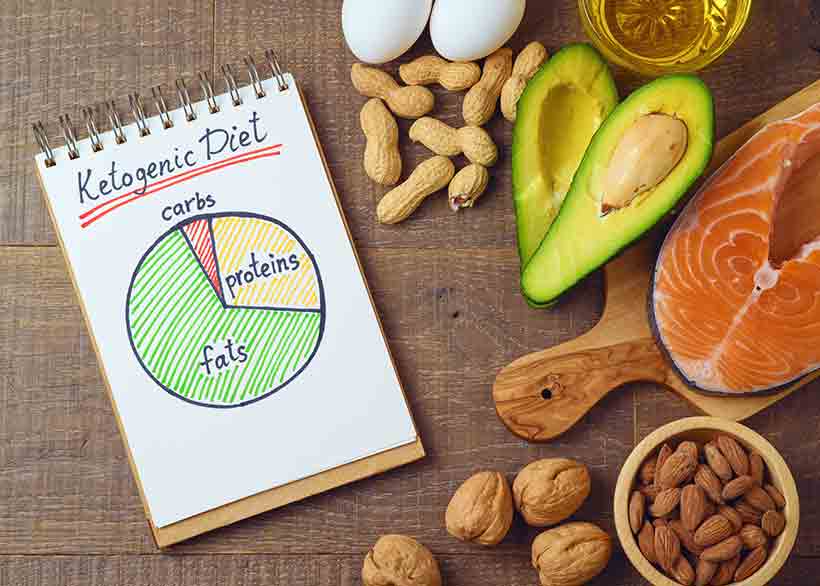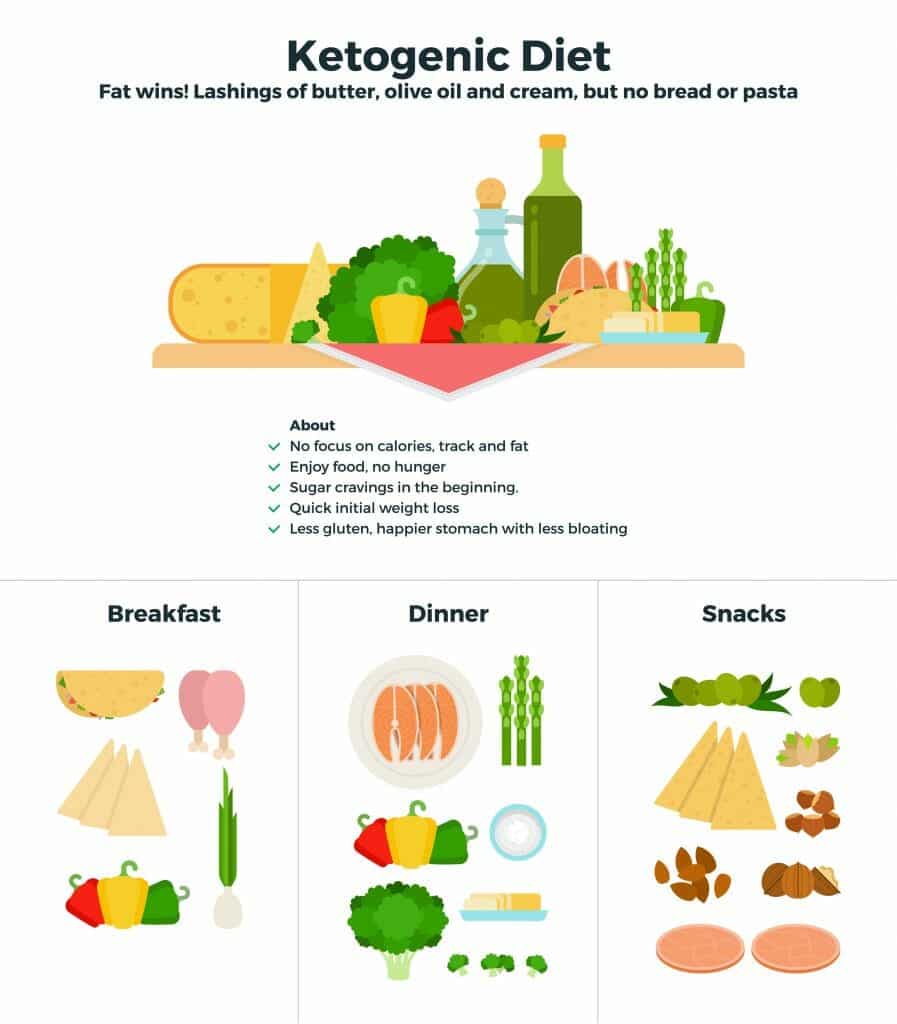If you are someone who is on the lookout for the right diet, then you are sure to have heard about the Ketogenic or Keto diet. It is said to be a common fad amongst celebrities and health enthusiasts. A quick media search can show you many instances of how some people were able to lose 50 Kilos and more on this diet.
When it comes to “Diet” all of us are familiar with the CICO (Calories In Calories Out) Theory. We have been taught that if we are burning out the calories we consume, we can eat how much ever we want. Or, that we need to watch how many calories we consume, doesn’t matter where the calories come from.
However, in the Keto Diet, one of the first things that is discarded is – counting calories. In this diet, there is no restriction on the number of calories one consumes. The focus is more on the type of food being consumed rather than just the calorie part.
So, what’s this diet that says you can eat anything without worrying about calories?
The Ketogenic (Keto) diet works based on the metabolic process called ketosis. Ketosis happens when you rapidly cut off carbohydrates from your diet and replace it with fats. Your body copes up with the starvation of carbohydrates by breaking down the fats into ketone bodies in your liver that act as the primary source of energy.
Table of Contents
What’s Ketosis?
Our body has two sources of energy to choose from.
- Carbohydrates – This gets converted to Glucose and is used by the body for energy. Glucose is a absorbed & burned easily. Any excess/ unused energy gets stored in the liver.
- Fats – This is used as energy after it breaks down into fatty acids. Any excess energy is stored in fat cells for later use.
When carbohydrates are consumed, glucose becomes the primary source of energy. An increase of glucose levels tend to increase the insulin production in our body. This is not an ideal to have high insulin levels in the long run as it can cause a condition called “Insulin Resistance“. Insulin Resistance is a metabolic disorder and a precursor to health diseases like obesity, diabetes, PCOS, BP, Sleep apnea, etc.
When glucose is used by the body for energy, the fats you consume is free from its job of fuelling the body and therefore, gets stored up. So, to avoid this we are forcing our body to the state of ketosis.
Ketosis is an everyday phenomenon that happens when your body is lacking in sugar. So, it is bound to happen regardless of you consciously cutting down carbs or not. But, when you cut down a larger portion of your carbs, the fats you eat and the ones stored in the body breaks down to fatty acids and glycerol to form ketone bodies. At this stage, when your body is in dire need of energy, it becomes entirely dependant on ketone bodies for sustenance.
This brings us to another question – Can fats not directly be used for energy? Well, fats are to a larger extent used by the cells in our body for energy. But the problem is that they do not help in giving sufficient energy to the brain as they take a longer time to get converted to produce energy. Therefore, ketosis is the ideal way of using up all the fats accumulated in the body and preventing spiking sugar and insulin levels.
How to Follow the Keto Diet
The Keto diet revolves around monitoring the levels of carbs, proteins and fats. On a regular diet that is High in carbs, the normal amount of carbs consumed is around 250-300g. In order to switch energy sources of the body, one would have to drastically reduce this number so that the body begins to recognize fats and starts using this for fuel.
Although there are several moderations to this diet, an ideal Keto diet would require a steep reduction in the intake of carbohydrates, consuming a moderate amount of proteins and liberally increasing fats. So, you’d typically have 5 – 10% carbs, 20-25% proteins and 70-75% fats in your diet.

Keto Diet Macros
Some other forms of keto diet are cyclical keto diet – where you have a combination of high carb and low carb days, targeted keto diet – where you take carbs only when you workout or get into any intense physical activity and high protein keto diet – that involves an increased protein intake than the standard diet.
Foods to Include in the Keto Diet
As mentioned earlier, our main focus is to cut down on carbs. There is no fuss of counting your calories or being watchful about your portions. At the same time you need to stay away from starchy and sugary foods, unhealthy fats, processed food, alcohol, beans and legumes. You can happily relish your meats, fish, eggs, cheese, butter, seeds and nuts. You are free to have a limited amount of low carb veggies like tomatoes and onions. Switch to healthy oils like olive oil and coconut oil and stick to unprocessed cheese and butter.
Here’s a list of items that are you can eat in plenty in this diet.
- Vegetables : All vegetables except starchy ones
- Dairy: Hung curd, cheese, yoghurt, paneer, etc.
- Meat & Seafood : all seafood, meat and eggs.
- Fats: Coconut Oil, Ghee, Olive Oil and Butter
- Nuts and seeds: All nuts and seeds except cashews.
- Condiments, spices and herbs: all are allowed
Foods to Avoid in the Keto Diet
Just like any other healthy eating plan, the first things to go are junk, processed and sugary foods. This would mean your pastas, cereals, coke, ice creams, candies, potatoes, chickpeas and refined oils are discarded from the diet. Even your sugar-free and fat-free products that claim to be “diet friendly” are to be cut off completely.
Here’s a list of all things to be avoided in this diet.
- Starches and Sugars: All starchy vegetables like potatoes, sweet potatoes and corn. Sugars of all types also need to be avoided.
- Processed foods: All sugary foods, desserts, packaged foods, instant foods, etc.
- Cereals & Grains: All grains and cereals are to be avoided as they are high in carbs. This also means, any food made using these grains are also excluded from the diet – pasta, taco, tortilla, rice, chapatis, burger buns, pizza bases, etc.
- Diet-friendly/ Low Fat products: Products labels these are to be avoided as they are typically ultra processed and have many additives.
The Benefits of Keto Diet
Although ketogenic diet was primarily crafted to treat epilepsy, people who have stuck to his diet have witnessed miraculous benefits.
- Tumors and Cancers: The diet prevents the risk of the growth of several types of tumors and cancers. Ketones do not give energy to the growth and multiplication of cancer cells, thus, preventing their occurrence or inhibiting their growth
- Weight Loss: Weight loss has been the primary benefit of this plan as fats are completely used up in the process
- Brain Clarity: The function of the brain drastically improves when it uses ketones for its energy. The keto diet has been effective in treating Autism, Epilepsy, Alzheimer’s and Parkinson’s diseases.
- Lower Insulin Levels: As the insulin levels are carefully controlled, the keto diet prevents Polycistic Ovarian Syndromes (PCOS) that is mainly caused by an imbalance of insulin.
- Diabetes Management: It is also very helpful in managing and in many instances reversing Type 2 Diabetes.
- Skin: As you tend to cut sugar and processed food completely from your diet, you will never have another episode of popping your pimples. This clean eating system de-clogs your skin and allows it to glow naturally.
- Anti-oxidants: Ketones function similar to antioxidants that protect you from any kind of reactive oxidative damage. So, sticking to this diet will help to maintain your youth and delays aging
A Few Downsides of the Keto Diet
- Time taken for ketosis: It takes anywhere between 1-2 weeks for the body to be fully adapted to Ketosis and hence the initial phase of this diet might affect the body in several ways that will leave you feeling giddy, exhausted and uncomfortable. Some of the common discomfort faced during the initial stages includes nausea, sleeplessness and indigestion. There are chances for varying levels of minerals, salts and water. However, these problems will decline while you slowly get used to the diet, with improved hydration and higher nutrients.
- Ketones may not be enough: Fuelling your body with just ketones wouldn’t be sufficient for you if you indulge in a lot of physical activities. A slightly higher percentage of carbs may be required.
- Discipline: The diet requires a very strict adherence to what can be consumed and hence tight discipline on part of the follower is mandatory for reaping the results. This dietary approach is more of a lifestyle than just a quick fix to weight loss or other problems.
Conclusion
Keto diet is seen as a lifestyle approach and not a quick fix to weight loss. Healthy eating in the long term is bound to show more benefits than any downside. Keeping a constant eye on the macros can be a little daunting at the beginning. But just like any other new habit, this too takes time and training. But as you adapt to the new style of eating and begin to understand your food choices, it becomes extremely easy to adopt and continue for long term.
You can reap the benefits of this diet only if you are persistent and patient. Although this is considered as a safe and healthy diet, it is ideal for you to consult your physician or a certified Low Carb Nutritionist before starting your journey on keto diet.

